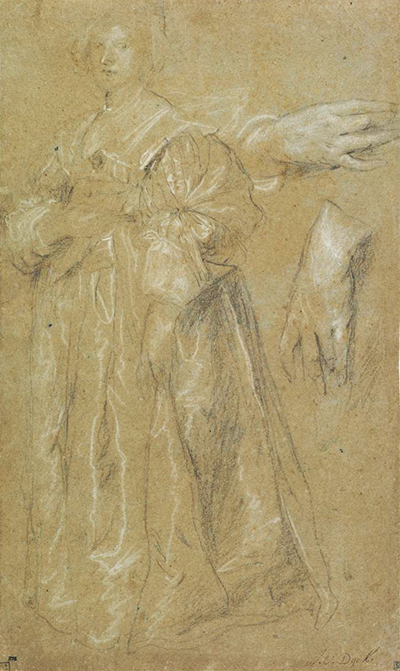This study drawing from Anthony van Dyck features a full length portrait with additional detailed work on the subject's hands
Van Dyck's own models were particularly famous for their slender features, including their hands. In this case he made the conscious choice of seeking to focus entirely on this part of the anatomy and take it to the very finest detail. This drawing has a good record of ownership, allowing us to follow its path from inception all the way up to the present day.
Most of its owners over the years have been fellow painters, suggesting that it was used as a source of learning for many over the centuries that have passed since.
The finest draughtsmen from the Renaissance and Baroque periods would frequently maximise their papers to hone their skills in anatomical depiction. Many single pages of sketchbooks would feature a combination of different studies together, with every spare space made use of. In those centuries paper would be more expensive and harder to source than it is today.
Anthony van Dyck himself preferred to use coloured paper for his drawings, tending to use dark chalk for the main detailed lines of his portraits. White chalk was then added at some points of his career in order to add depth to the areas that he felt deserved the most focus. To see an artist pay particular attention to a single part of the anatomy gives us an intriguing insight into the mind of a master, someone who felt his extraordinary skills still required fine tuning in certain areas.
Albrecht Durer produced hundreds of study pieces for his own development as a portrait artist. Who can forget his praying hands for example but there were many more besides. Rubens and van Dyck also went to extraordinary lengths to in order to hone their skills and you will see that in the endless production of study drawings throughout their careers.
Many Leonardo da Vinci drawings also practiced the art of capturing the human anatomy. It was an essential ingredient to so much of his work that accuracy was critical to his entire oeuvre. Whilst considered a master, a genius, Da Vinci still had to work hard at his craft just like anyone else. The difference was that he started from a higher plain than us mere mortals would have, and he also picked up new ideas far more quickly.




